HANGING PORCH SWING
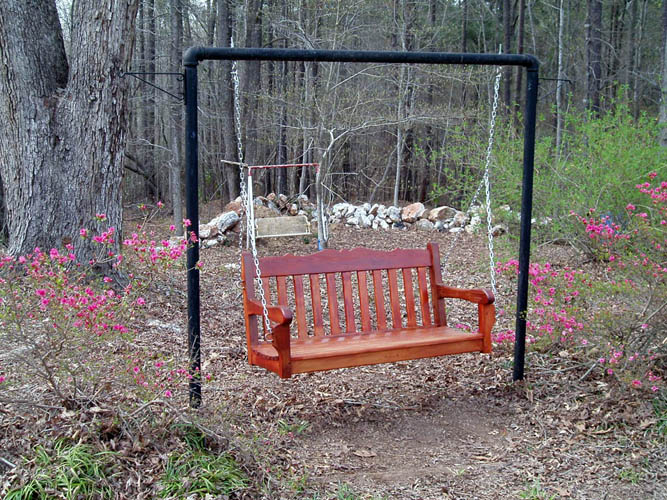
Just a swinging!
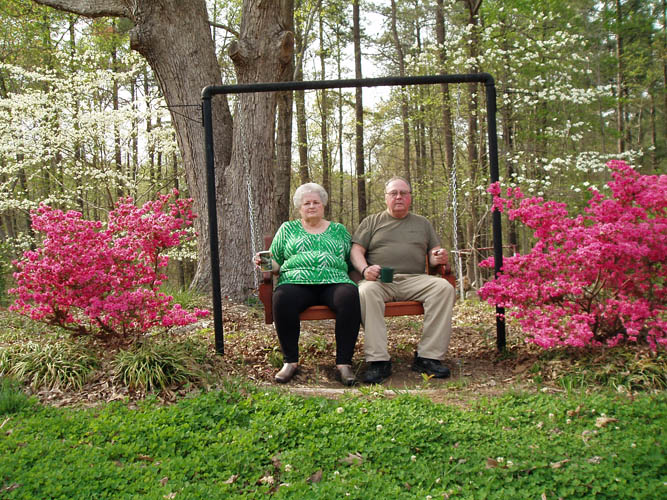
As far back as I can remember our parents and grand parents had a porch
swing hanging from their front porch or from a heavy timber support
frame in their yard. I have certainly did my share of swinging back
and forth in a porch swing as a youngster and into adulthood as well.
The closest thing to swinging (country style)
not the modern day swinger would be a good hardwood rocking chair
ergonomically designed to fit your lower posterior and back with a good seat
cushion...grin if you must. I believe former President John F.
Kennedy made the
Boston Rocker very popular while he was in the oval office.
Our Pop, William Allen Porter (deceased) made hanging porch swings for
many decades that were of a simple design and construction with
whatever scrap materials he scrounged up, yet they were very comfortable and
that is the main element. Pop later on refined his swing design and
purchased treated 5/4 bull nose decking material but did not have a woodworking
shop with an abundance of power tools but relied on hand tools. He did
have a powered circular saw and hand drills but that was about the extent of
it. He used an old fashioned
drawknife to fabricate the curve in the
seat and back frame members and used chisels and block planes at times as well.
He built us our first swing when we lived on White Store Road, now a vacant
lot and another one a few years before his passing on
August 10,
2007 of which I gave to our oldest daughter.
HAYWOOD NEWTON SWING CIRCA. 1989
Our 1989 swing was custom made by one of my Brother-in-Laws,
Haywood Newton of Lilesville, NC and was presented as a house gift when we purchased our home.
The
outdoor elements finally took its toll on the swing and for the past two years
was getting in very bad shape and a safety hazard. I added a couple
aluminum angle braces for additional support which kept it going, but it was
time to replace it which brings us now to this short story.
Pix below taken on 06-04-2001, both Mom and Pop (front row) are
deceased and certainly do miss them:
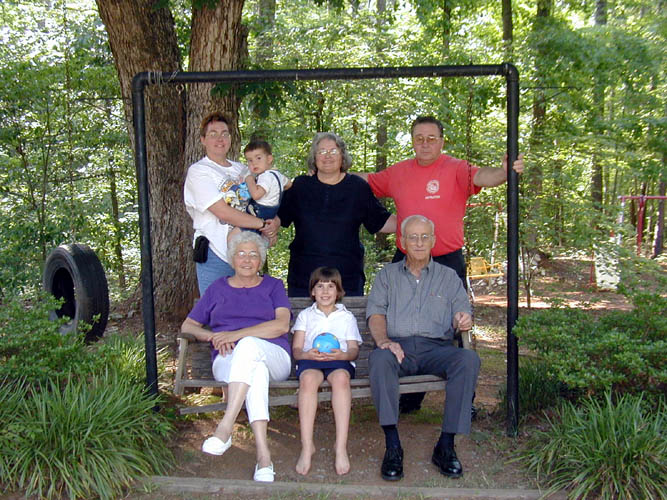
PERSONAL SAFETY AND LIABILITY ISSUES
My goal will be to keep Safety
paramount because hand and power tools can do serious bodily harm and death
if not used properly, therefore these pages are solely for
entertainment purposes only from
a personal liability standpoint. Please read the
Legal Stuff
page for additional information concerning liability issues
before going any further. Safety glasses and hearing protection is a must
although I do forgo the hearing protection many times; my bad!
LETS GET STARTED
I did some internet research on swing designs and plans and decided on
one that Norm Abram of the
New Yankee Workshop did a few decades ago,
however I
could not afford to use the high dollar teak wood that he did or just
couldn't rationally justify it......a little frugal I guess . What
impressed me about his design was the joinery was mainly
mortise and tenon
which is one of the oldest methods to attach things together for strength. I
used the back upper rail support design from another set of plans which had a decorate
curve instead of just straight. I elected to use treated wood and purchased enough 4 x 4 x 8
feet length timbers and 5/4 treated bull nose decking pine to construct the hanging porch swing and
stacked the wood in my basement workshop on stickers for more than 6 months
to let the excess moisture dry out. Treated wood from the lumber yards and
suppliers are soaking wet since they turn over such a large inventory the
wood
doesn't have enough time to dry out. Deck builders will have the
treated wood installed
before it has a chance to move around much while it is still moisture laden.
Since I planned to ripsaw the 4 x 4s with a band saw, I wanted the timbers
to dry out and get all their twisting, cracking, checking, etc. done of
which I did loose at least one 4 x 4 x 8 due to such cracking and twisting.

After the wood was properly dried, I band sawed the 4 x 4s at least 2
inches in width to allow for a final surface planed thickness of 1 and 7/8 inches.
A pix of some re-sawing on the band saw sometime in January of 2013.
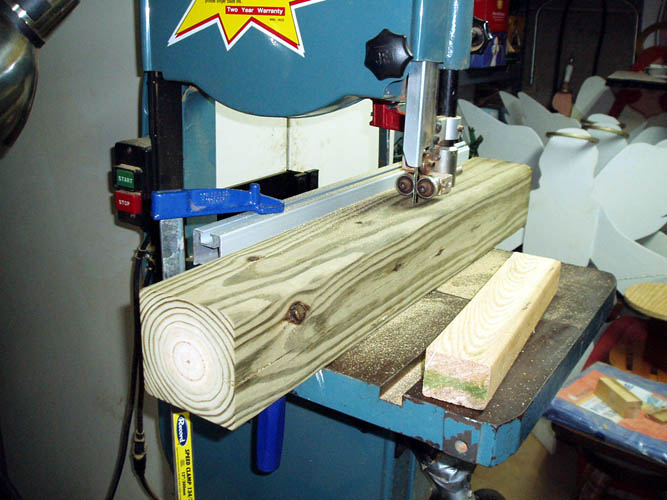
The timber companies sure do harvest small trees as evidenced by the
center growth rings of the above 4 x 4 which is more 3.5 x 3.5 inches.
That tree should have made pulpwood versus a post!
One thing I quickly found out about the New Yankee Workshop
"measured drawings", they are
that and not true to scale. You have to get 1 inch grid paper and do
all the curve plotting which is a pain and headache. It would have
been much easier to take the measured drawing to a place that has the
capability to enlarge the drawings to actual scale instead of plotting the
curves on the grid paper. Click on thumbnail pixs for a larger screen
view:
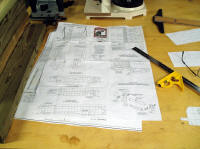

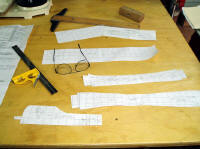
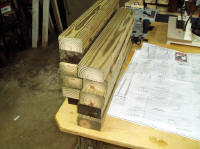
After getting full size paper patterns drawn out and the 4 x 4s cut and
surface planed to thickness, it was time to layout the mortises for the swing end
frames. I needed a
mortise layout tool
which simplifies this job of which I didn't have and did
it the hard way.


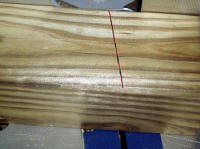
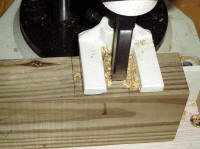
This swing required a total of 38 mortises to be plowed or excavated into
the wood and the video that came with the "measured drawings" showed Norm
Abram using a plunge router but I decided to use a dedicated mortise machine
made by Shop Fox which worked out pretty well since I used all 1/2 inch
width mortises instead of 3/8 inch width mortises that were used on the seat
back slats and connecting rails to the end frame pieces per Norm's drawing
and DVD.
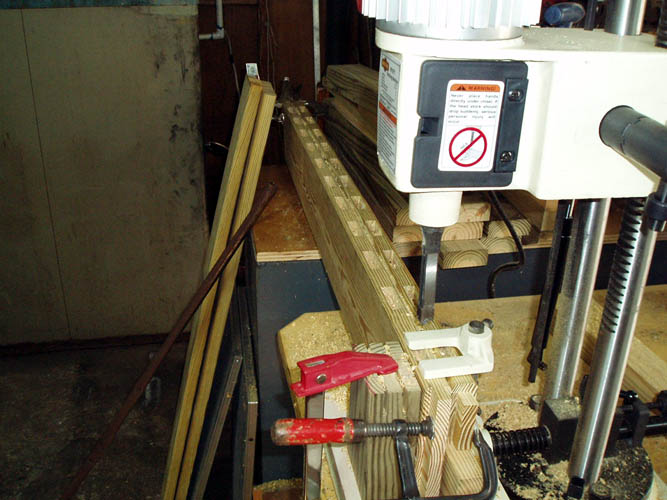
Picture of the
Shop Fox Mortise Machine set up to excavate the mortises into the two
back rail members. This machine is fairly rugged but it still takes
some effort to get the end mortises started since the square chisel has to
cut the end of the mortise square and that is by "brute force" for sure.
After all the mortises were hollowed out and touched up with a 1/2 inch
width chisel, especially on the ends, it was time to start cutting the
matching tenons. I used a
Delta Universal-Deluxe Tenoning Jig on the table saw to cut most of them
but did use the band saw to cut a couple of the end cheek pieces.

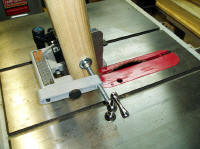
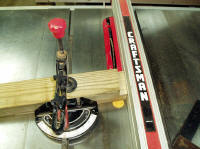
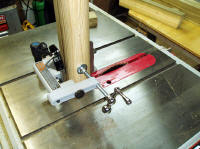
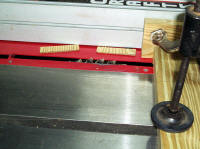
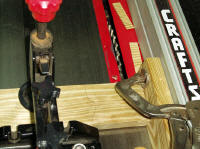
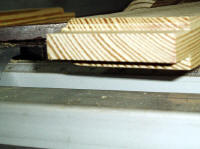
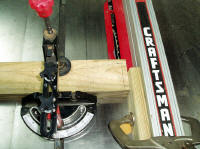
It has been many decades since doing any mortise and tenon joinery and
that was in the Industrial Arts Class at the ole Wadesboro High School back
around 1962 or 1963 under the tutelage of David Kephart, therefore my learning curve had to get out of its
dormancy and certainly did do several trial cuts to get the tenon jig
properly set up. Most of these type of fixtures and jigs have
calibrated scales or dials, whereas some will get you in the ball park but
the final tuning is up to the individual user to get it adjusted and dialed
in.
After the mortises and tenons were done for the end frames, it was trial
fitting time before the curvatures were band sawed to their final shape.
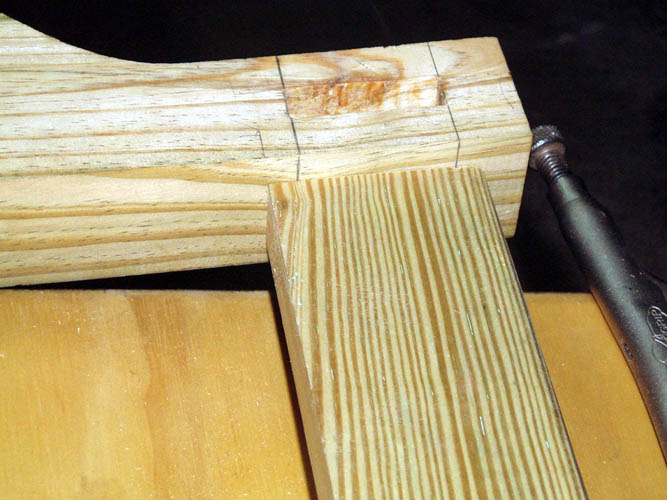
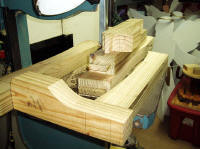
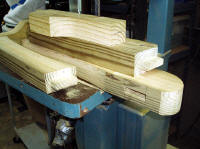
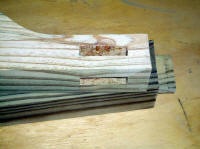
The armrests were rounded over with a 1/2 inch round over bit that had a
pilot bearing on the end. I failed to get a few pixs for that
operation and the trial fitting of the rectangular armrest and support
members.......my bad.
Below is trial fitting the end frame pieces and the back rest mortises and
tenons prior to gluing the end frames up.
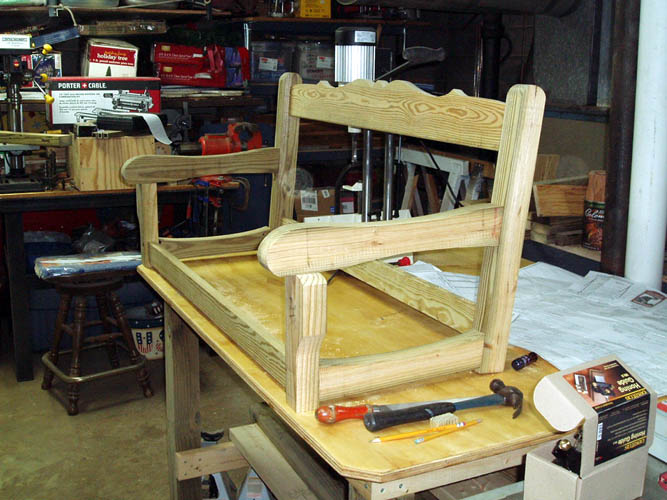
Each armrest frame's mortises and tenons glued using pressure exerted
between
Bessey 3/4 inch pipe H
style clamps. You will need about 4 or 5 that are at least five (5)
feet long to glue the entire swing frame together once the end pieces are
glued, pinned and sanded.
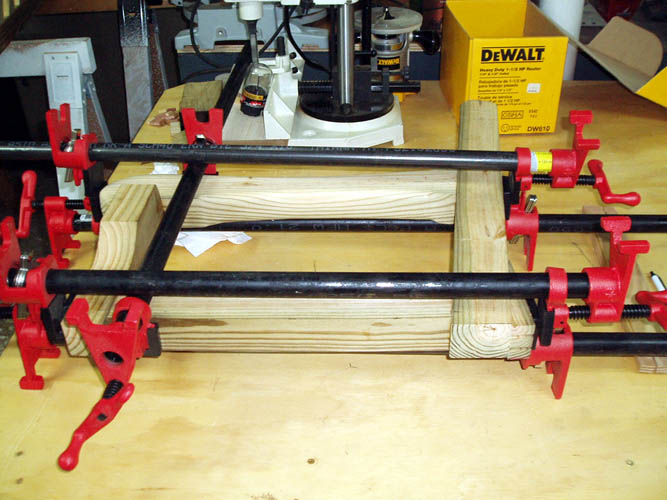
After the
Titebond III
Ultimate Wood Glue dried over night, it was time to
drill a couple 3/8 inch diameter holes through each mortise and tenon and insert a
3/8 inch diameter red oak wooden dowel for extra strength even though the
Titebond glue is actually stronger than the wood itself.
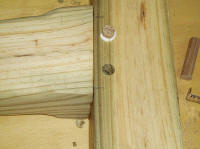

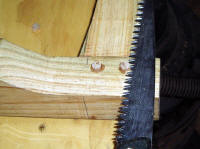
NOTE: The mortise and tenon is one of the oldest forms of
joinery and dates back to around 3000 BC to 2000 BC
Stonehenge of which the top
lintel stones had mortise and tenon fittings on
them. It is the strongest method to join end grain woods
together. Manufacturers elect to use screws, staples, nails and bolts
which is less labor intensive which spells out more profits.
The
bow eyes were installed into each front armrest upright support member
and the rear back rest rail support and all were countersunk with wooden plugs
covering the washer and nut installation. The bow eyes were 3/8 inch
diameter with a one (1) inch eye inside diameter with about three (3) inches of exposed
threads and a flat plate/washer. The screw length had to be shortened by over an inch for the
back rail support but were fine for the front upright armrest support
members. The one (1) inch diameter tapered plug was formed with
a plug cutter and the plugs were removed from the material by running over
the table saw blade instead of trying to pop them out with a screw driver.
Loctite was applied
to each nut threads to keep them from ever coming loose since they are
hidden from view by the plug.
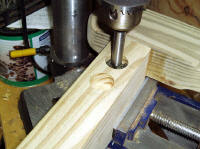
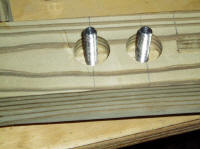
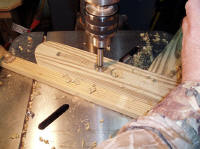
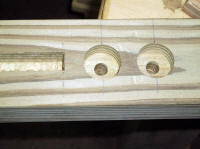
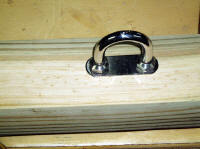
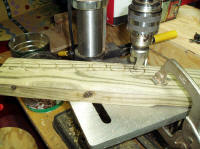
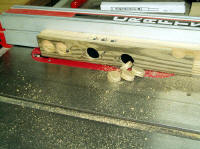
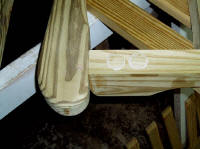
Once the glue dried from the 1 inch diameter tapered plugs installed that
fit the 1 inch diameter countersunk hole, I used an ole Craftsman hand block
plane to cut the exposed plug ends flush with the upright armrest post support and the
back rail support member. I could have used my belt sanding station or
hand orbital sander but decided to do it with the hand block plane in memory
of my Pop. I sure do miss him but I have many, many wonderful memories
locked in the ole brain of the good times we shared.

It is a tragedy that so many young kids today do not have the benefit of
two loving parents to nurture and guide them along Life's journey at a time
when they need it the most! Young couples today, do not take the time
or energy to make their marriage successful as evidenced by the growing
number of divorces which are detrimental to the children along with the
morbid and moral decay of same sex marriages and their "partners."
View this page:
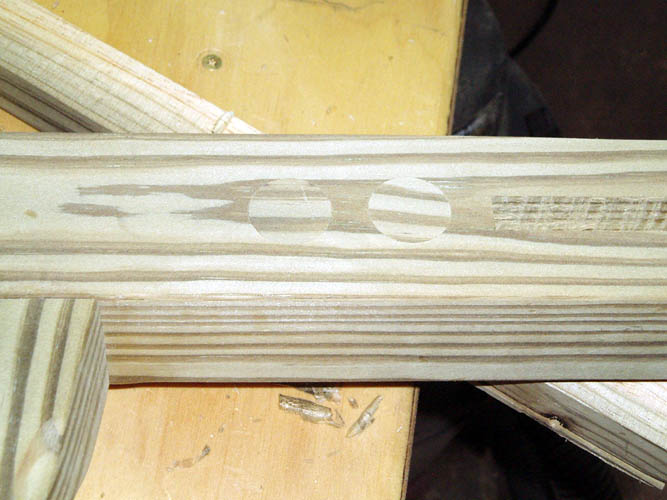
I changed the design on the back rest slats and used the 5/4 treated bull
decking material planed down to 3/4 inch and cut a tenon on each end and a
1/4 inch radius on each side about 1 inch from each end. The back
slats free float in the back rail mortises and only the center back slat is
glued in place. Prior to test fitting the back rest slats, the center
seat brace support was test fitted which also had a tenon on each end.
The center seat support has the same curvature as each end piece. This
pix was taken before the end pieces were glued up and the bow eyes
installed.
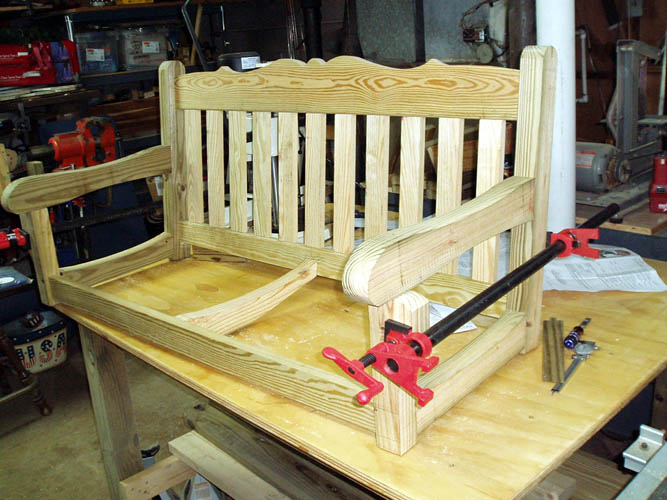
With the end pieces and bow eyes installed, the back rails and back slats
were fitted which one needs about two extra hands in order to do so.
This is the time for several five (5) feet length pipe clamps to get a good
glue up.
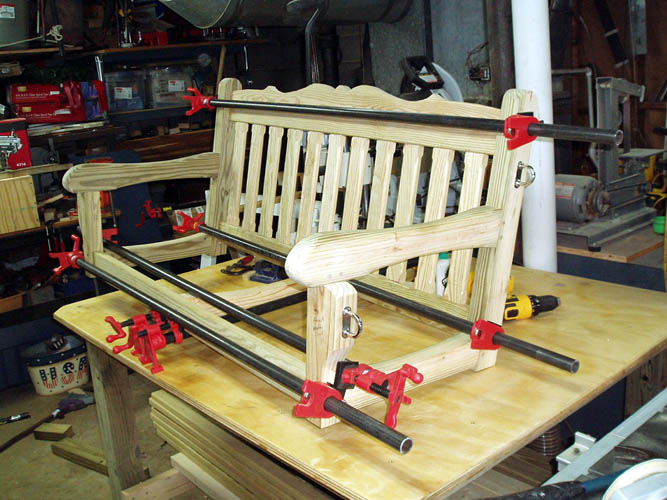
Once the glue has dried, holes will be drilled through the back rest
rails and red oak wooden dowels will be glued and driven in place, allowed
to dry and flush cut off with the surface and sanded the same as with the
armrest support frames.
The next detail was cut the seat slats to width and length, route a 1/4
inch round over on the upper edges of each seat slat, drill a pilot hole and
countersink for each screw (# 8 zinc plated 1 1/4 inch length) and install. I reduced the width of the
seat slats in order to better follow the curvature of the seat support frame
members which increased the total number of slats from six (6) to eight (8). I left a 1/4
inch space between each slat to allow rain to freely travel between them since
this swing will be in the elements 24/7 unless I decide to place a permanent
roof over the swing and steel pipe swing support structure, of which I might do
even though the swing will be under the overhang of a large white oak tree.
The front seat slat has a 3/8 inch round over routed on its leading edge to
keep it from digging into your legs. I then cut red oak 3/8 inch
diameter wooden dowels to length,
applied glue and drove them over the countersunk # 8 screws. You need a
right
angle drill to sink the screws underneath the armrest or use a short handled
screw driver, otherwise you will be driving them in at an angle which is not
good and likely to distort the predrilled countersunk hole for the plug covering the countersunk screws
and wallow out the screw head before fully seating the seat slat tightly against
the end support frame members.
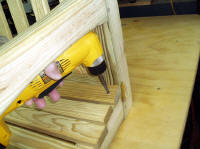
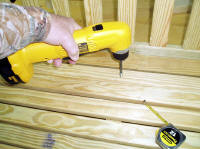
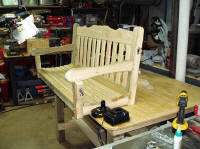
After a final sanding with 100 grit paper; grin, this is no musical
instrument requiring a deep mirror finish, I applied a stain manufactured by
Cabot;
product Australian
Timber Oil in a Mahogany Flame color # 3459. I applied it with a
natural China white soft bristle brush but the stuff was a
"dawg" to
penetrate
into the treated wood, especially on the back rest rails and slats.
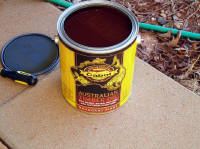
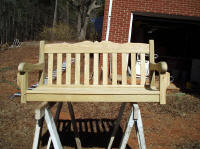
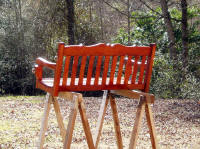
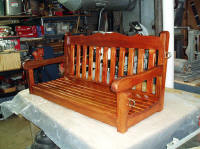
REMEMBERING POP
Below is a picture of Pop taken in the mid 1960s or maybe a little earlier with
my dog Brownie. I stretched this porch swing project out a couple
months once I got the wood dried and the 4 x 4s band sawed to width.
This swing could easily be done in a few days with the majority of down time due to
allowing the mortise and tenon joinery to dry. I believe I was still in the
US Navy at the time and took this pix while home on leave......a good
guess at the best! Throughout this porch swing project, I kept Pop on
my mind regularly, because I know how he loved to make his swings and
received so much satisfaction of his finished product. He gave
many to family members and sold quite a few of them over the decades.
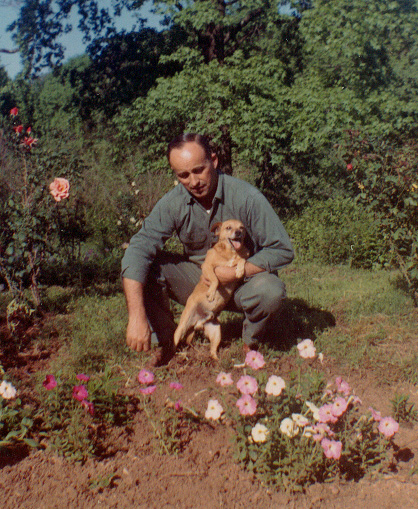
My sister Susan Pettigrew of Reidsville, NC took the pix below a few days ago
of a swing that Pop made for her in 1988 as a birthday present,
whereas this swing
appears to be still going strong. Susan aka SusieQ said they treated it every few years
with a coat of Cedar stain which helped prolong it's life span. Pop's swings were very comfortable to
sit and swing in and I hope the Norm Abram design will sit and swing that
good too.
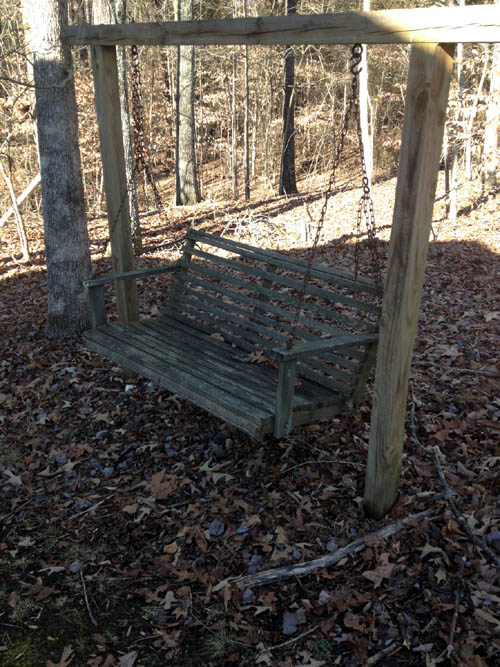
Below Pop with one of his swings for sale.
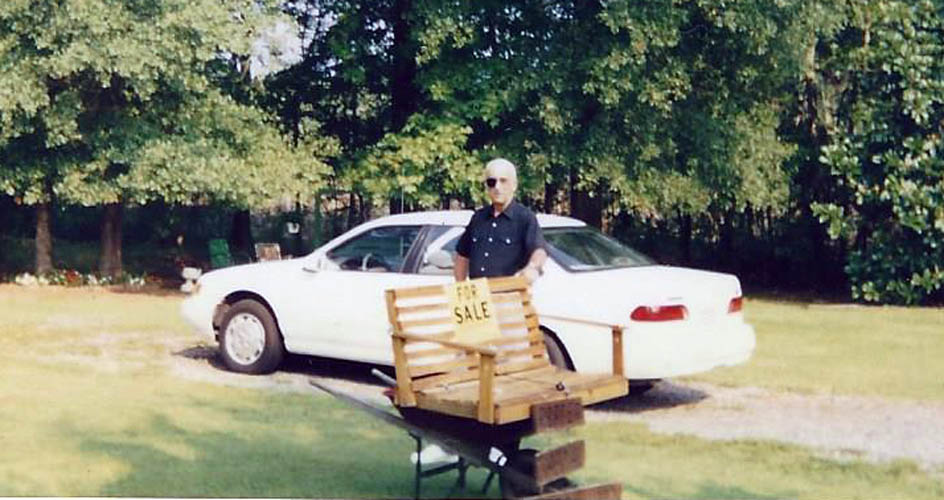
After the porch swing stain dries and the tree arborist cut back the
large White Oak tree in our front yard, I will hang the swing and take a picture
and post it here. Don't even think about asking what I would charge to make another
swing with the Norm Abram mortise and tenon design. I probably have over 70 dollars in stainless
steel hardware alone; bow eyes, shackles, etc. and haven't even purchased
the heavy duty chain yet. This hanging porch swing was definitely a labor of love!
You can purchase a cheap made but functional hanging porch swing at many places including Wal-Mart and I certainly
would not
begin to compete with a 75 or 100 dollar swing or desire to make one. As I have said and
eluded to many times throughout this website, "Most of the time, you get
what you pay for." If I do build another
hanging porch swing, it will probably be out of 10/4 Honduras Mahogany and
finished with a clear oil based protective finish; very, very high dollar indeed!
My next woodworking project will be a pair of
Adirondack chairs; hopefully I
can locate some good cypress lumber reasonably priced. On my
bucket
list is a special
inlaid box for my bride.......haven't formulated or
committed the design to paper yet but have a few ideas floating around.
NOTE: I tabled the Adirondack chairs project due to my
bride's health issues, whereas she would not be able to use said chairs.
Below a couple pixs of the finished swing hanging in the front yard.
My bride and myself have already "field tested" the swing and we are both
very well pleased with the way it looks, sits and the most important part
swings:
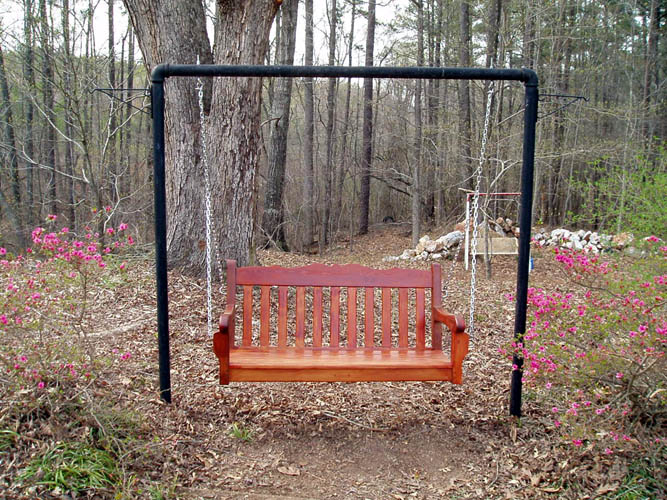

I will have to sit the tripod up and get a pix of us "swinging".....grin if
you must!
This short story and swing is dedicated to the memory of my Pop, William Porter,
February 6, 1926 - August 10, 2007.
Web published by Bill aka Mickey Porter on 02-21-13.
SWING MAINTENANCE
During the past year and
a half, the above hanging porch swing has received a good amount of personal
usage by my bride and I. There is nothing as relaxing as sitting in a
good designed swing early in the morning after day break enjoying a good
fresh brewed cup of coffee taking in all the sights and sounds that Nature
has to offer, especially if you leave far enough from the main roads or live
at the end on a dead end street such as we do surrounded by woods. As
with most outdoor wooden things subject to the constantly changing
conditions and UV, some type of routine maintenance is required to keep your
wooden yard furniture, etc., in top shape. Even with all the high tech
finishing materials that are available, you still have to apply additional
protective finish if you want the item to last a life time. I placed
the swing in my basement workshop for about a month to let it acclimate to
less humid conditions and allow the wood to get to its normal state before
applying a fresh coat of stain and a couple coats of exterior finish.
Below is pix of the above swing air drying:
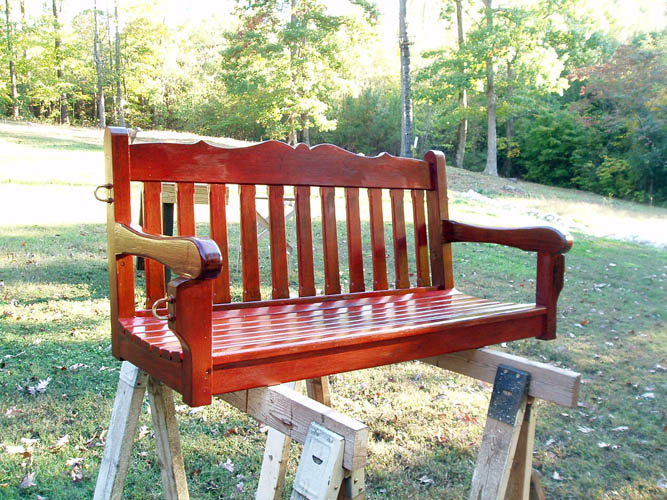
I placed the swing back into my basement workshop and will let it
continue to stabilize/acclimate before placing back outside come spring of
the year. The swing looks brand new again!
Web published update by
Bill aka Mickey Porter on 11-02-14.
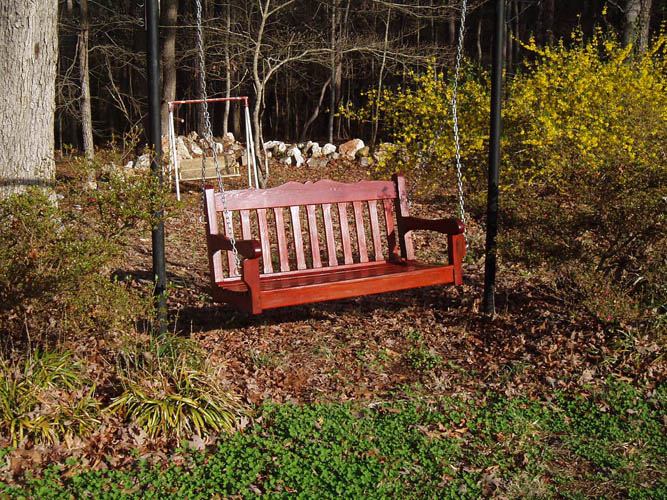
Got the swing hanging in
the front yard again and my bride and I have enjoyed
"Just A Swinging".
Web published update by Bill aka Mickey Porter on 03-24-15.
LEAVING ON A
SPIRITUAL NOTE
If you do not know Jesus Christ as your Lord and Savior, please take
this moment to accept him by Faith into your Life, whereby Salvation
will be attained.
Ephesians 2:8 - 2:9 8 For by grace are ye saved through
faith; and that not of yourselves: [it is] the gift of God: 9 Not of
works, lest any man should boast.
Hebrews 11:1 “Now faith is the substance of things hoped for,
the evidence of things not seen.”
Romans 10:17 “So then faith cometh by hearing, and hearing by
the word of God.”
Open this
link about faith in the King James
Bible.
Romans 10:9 “That if thou shalt confess with thy mouth the
Lord Jesus, and shalt believe in thine heart that God hath raised him
from the dead, thou shalt be saved.”
Open this
link of Bible Verses About Salvation,
King James Version Bible (KJV).
Hebrews 4:12 “For the word of God is quick, and powerful, and
sharper than any two edged sword, piercing even to the dividing asunder
of soul and spirit, and of the joints and marrow, and is a discerner of
the thoughts and intents of the heart.”
Romans 6:23 “For the wages of sin is death; but the gift of
God is eternal life through Jesus Christ our Lord.”
Romans 3:23 “For all have sinned, and come short of the glory
of God;”
Micah 6:8 “He hath shewed thee, O man, what is good; and what
doth the LORD require of thee, but to do justly, and to love mercy, and
to walk humbly with thy God?”
Philippians 4:13 "I can do all things through Christ which
strengtheneth me."


